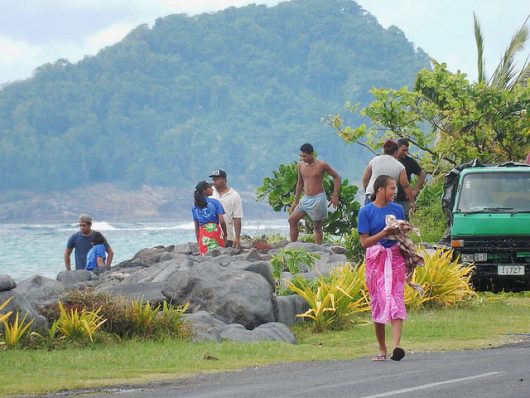The Main Causes of Poverty in Samoa

Samoa is one of the most stable islands in the Pacific region. Its economy is reasonably healthy and the average family earns lower-middle incomes. As a developing nation, Samoa has made many impressive strides toward meeting the Millennium Development Goals.
Extreme poverty is very uncommon in Samoa. However, according to the Asian Development Bank, approximately 22% of the country’s population lived below the national poverty line in 2018. The causes of poverty in Samoa ultimately boil down to lack of access to education, youth unemployment and underemployment, gender inequity and threats to natural resources and farming land, such as natural disasters.
Disparity in Education
The gap between education in rural and urban areas is staggering, with few schools in the countryside and a need for updated curricula and textbooks in many areas. In a 2016 report, 7% of individuals aged 3 and older residing in rural Samoa had never attended school, compared to 6% in urban areas.
Further, many rural children go into agricultural jobs too early, jobs that ultimately are not sufficient to support families later on. Working out of necessity instead of continuing with education furthers the cycle of poverty in rural areas of Samoa.
Youth Unemployment
Another cause of poverty in Samoa is youth unemployment or underemployment, particularly between the ages of 15 and 24. The unemployment rate for people aged 15 to 24 is approximately 20%, while the overall unemployment rate stood at 10% in 2022. Unemployment is more prevalent among women aged between 15 and 24, at 24.5%, compared to men at 16.7%.
There is a noticeable lack of opportunity and social benefits in rural areas that disadvantage the growing youth community in Samoa, especially as the youth population increases and puts pressure on existing resources. There is also a disparity between men and women in Samoa, with many jobs, especially in agriculture, restricting women. This disparity results in a significant difference between male and female incomes in the country, contributing to family poverty.
Natural Disasters
Increasing natural disasters such as cyclones threaten marine and agricultural resources, causing communities to take a long time to recover from the devastation they inflict. While Samoa’s soil is fertile, it is very shallow and prone to erosion. These features are only intensified by rising temperatures and population increases, causing land degradation and shortages of resources.
Most Samoans rely on agriculture for their income, so any threat to their livelihoods affects them. To prevent environmental degradation and preserve Samoa’s natural resources, sustainable farming, fishing and logging practices must be implemented immediately.
Looking Ahead
Overall, Samoa is a moderately productive and stable country in the context of the Pacific region. However, more work can be done to ensure that the next generation of youth is employed and has the same natural resources at their disposal as their ancestors did.
Hopefully, these changes will be made with the implementation of sustainable agricultural practices. Samoans can expand from agriculture into manufacturing to continue working toward achieving their Millennium Development Goals.
– Saru Duckworth
Photo: Flickr
Updated: May 29, 2024
